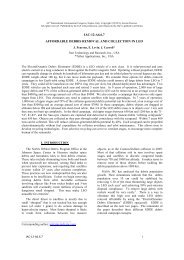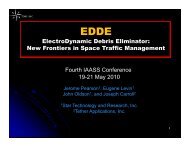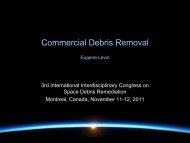The Cost of Future Collisions in LEO - Star Technology and Research
The Cost of Future Collisions in LEO - Star Technology and Research
The Cost of Future Collisions in LEO - Star Technology and Research
Create successful ePaper yourself
Turn your PDF publications into a flip-book with our unique Google optimized e-Paper software.
12<br />
where F ki (m) is the cumulative distribution (8), H n is the average altitude <strong>of</strong> the<br />
asset A n , <strong>and</strong><br />
k n =<br />
ω n<br />
2π 2 .<br />
R n<br />
Fig. 6. Post-collision <strong>in</strong>crease <strong>of</strong> the debris flux on sun-sync<br />
assets: a) m > 0.5 g, b) m > 1 g, c) m > 2 g.<br />
<strong>The</strong> flux <strong>of</strong> fragments with masses between m <strong>and</strong> m + dm is calculated as<br />
Ψ n dm, where<br />
Ψ n ≈ k ∑<br />
n<br />
β nk P ki f ki (m) g ki (H n ). (22)<br />
P c<br />
k,i<br />
Formulas (17) <strong>and</strong> (21) characterize the current state <strong>of</strong> the <strong>LEO</strong> debris field<br />
<strong>in</strong> terms <strong>of</strong> the average statistically expected production <strong>of</strong> small fragments <strong>in</strong> a<br />
catastrophic collision between large objects. Fig. 6 shows how the fluxes on sunsync<br />
assets will <strong>in</strong>crease on average <strong>in</strong> three different fragment mass ranges after<br />
a catastrophic collision. <strong>The</strong> virtual fluxes peak around 900 km, because this is<br />
where the primary sources <strong>of</strong> the future fragments are concentrated.<br />
It is <strong>in</strong>terest<strong>in</strong>g to note that a fairly accurate approximation for the overall<br />
flux can be obta<strong>in</strong>ed by replac<strong>in</strong>g the weighted distributions (14) <strong>in</strong> formulas (21)–<br />
(22) with the base distributions (12) centered around the middle <strong>of</strong> the altitude<br />
overlap. It works because the altitude overlaps are typically small compared to the<br />
scale heights <strong>of</strong> the altitude distributions, <strong>and</strong> because the number <strong>of</strong> objects is<br />
large.<br />
5. <strong>The</strong> cost <strong>of</strong> a catastrophic collision<br />
<strong>The</strong> cost <strong>of</strong> a catastrophic collision <strong>in</strong>cludes an immediate loss, if an asset was<br />
destroyed <strong>in</strong> the collision, <strong>and</strong> a delayed loss, if other assets were damaged later








